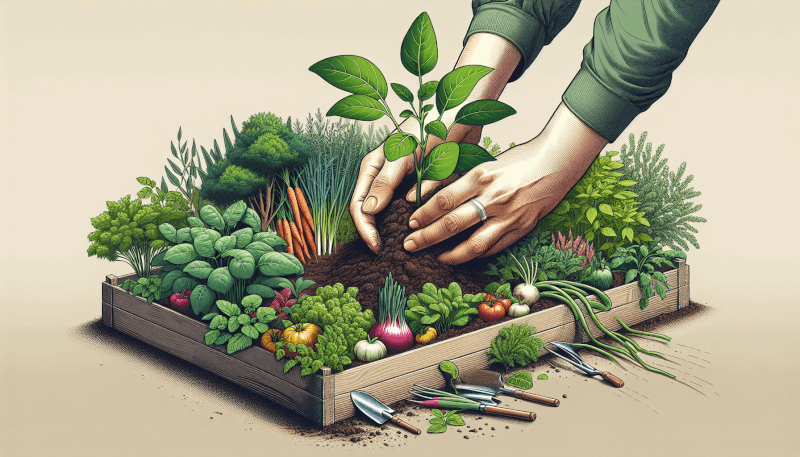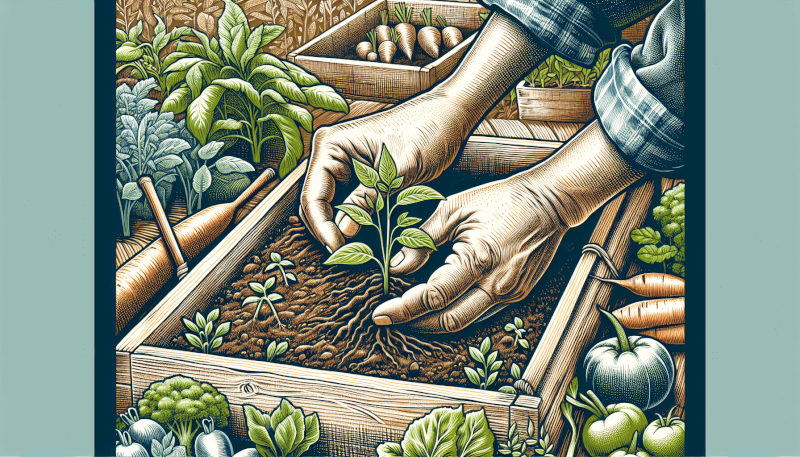Building raised beds for growing healthy ingredients is easier than you may think. Whether you have limited space or want to improve the quality of your soil, raised beds offer numerous benefits for aspiring gardeners. In this article, you will discover step-by-step instructions on how to construct your own raised beds, providing a sturdy and convenient solution for cultivating a thriving garden. Whether you are a seasoned gardener or a beginner, these simple techniques will have you on your way to growing your own nutritious and delicious ingredients in no time.

Materials Needed
To build your raised bed, you will need the following materials:
Wood
The primary material you will need is wood. Opt for untreated wood, such as cedar, to ensure it is safe for growing plants.
Screws
Screws will be necessary to secure the wooden boards together and provide stability to the raised bed frame.
Drill
A drill will be essential for creating holes and screwing the boards together. Make sure to have the appropriate drill bits for the size of screws you are using.
Measuring Tape
Accurate measurements are crucial when building a raised bed. A measuring tape will help you determine the dimensions for your bed.
Level
A level will come in handy to ensure your raised bed is even and balanced. This is important to promote proper drainage and prevent waterlogging.
Landscape Fabric
Landscape fabric serves as a barrier to prevent weeds from infiltrating your raised bed. It allows water to drain through while keeping the soil in place.
Staple Gun
A staple gun is necessary for attaching the landscape fabric securely to the raised bed frame.
Choosing the Right Location
Selecting the ideal location for your raised bed is crucial for the success of your plants. Consider the following factors:
Sunlight
Most plants require at least six hours of direct sunlight each day. Find a spot in your garden that receives ample sunlight throughout the day to ensure optimal growth for your plants.
Drainage
Ensure that the chosen location has proper drainage. Avoid areas prone to standing water, as this can lead to root rot and other moisture-related issues.

Preparing the Ground
Before building your raised bed, it is essential to prepare the ground properly. Follow these steps:
Clearing the Area
Remove any grass, debris, or weeds in the designated area. This will help prevent unwanted growth within your raised bed.
Leveling the Ground
Use a shovel or rake to level the ground where your raised bed will be placed. A flat surface will provide stability to your raised bed and promote even water distribution.
Building the Raised Bed Frame
Now it’s time to construct the frame for your raised bed. Follow these steps:
Determining the Size
Decide on the dimensions for your raised bed. Consider your available space and the types of plants you intend to grow. Remember to make the width of the bed narrow enough for easy reach from all sides.
Cutting the Wood
Measure and cut the wooden boards according to your desired dimensions. Be precise to ensure a snug fit during assembly.
Assembling the Frame
Using your drill and screws, join the wooden boards together to form the raised bed frame. Double-check that the corners are squared and the frame is sturdy.
Securing the Corners
To provide additional stability, install corner brackets or brackets with braces at each corner of the frame. This will help prevent sagging or bowing as the soil settles.

Adding the Landscape Fabric
To prevent weeds from infiltrating your raised bed, follow these steps:
Placing the Fabric
Line the entire interior of the raised bed frame with landscape fabric. Make sure it fits snugly against the walls of the frame.
Stapling the Fabric
Use a staple gun to secure the landscape fabric to the wooden frame. Place staples every few inches along the fabric’s edges to ensure it remains securely in place.
Filling the Raised Bed
Now that your raised bed frame is complete, it’s time to fill it with nutrient-rich soil. Follow these steps:
Soil Type
Choose a high-quality soil mix that suits the plants you plan to grow. Look for a mix that provides good drainage and retains moisture while offering essential nutrients.
Adding Compost
Incorporate compost into the soil to enhance its fertility. Compost adds valuable organic matter, improves soil structure, and provides essential nutrients for your plants’ growth.
Leveling the Soil
Fill the raised bed with soil, leaving a slight indentation near the edges to hold water during watering. Use a garden rake or your hands to level the soil, ensuring it is evenly distributed.

Watering and Drainage
Proper watering techniques and drainage are essential for the health of your plants. Consider the following:
Watering Techniques
Watering your raised bed correctly will depend on your plants’ moisture needs. Avoid overwatering, as excessive moisture can lead to root diseases. Water slowly and deeply, allowing the water to penetrate the soil.
Irrigation Systems
Consider installing an irrigation system, such as drip irrigation, to ensure efficient and consistent watering. This will save you time and help maintain the ideal moisture level for your plants.
Ensuring Proper Drainage
To prevent waterlogging and ensure proper drainage, make sure your raised bed has drainage holes or gaps between the boards. This will allow excess water to escape, preventing root rot and other water-related issues.
Choosing the Right Plants
Selecting the right plants for your raised bed is crucial for a successful harvest. Take these factors into account:
Consider the Climate
Evaluate your climate and choose plants that thrive in your specific region. Some plants prefer cooler temperatures, while others require hot and sunny conditions.
Grow What You Love
Consider your taste preferences when deciding which plants to grow. If you enjoy cooking with certain herbs or vegetables, prioritize those in your selection.
Know Your Soil
Be mindful of your raised bed’s soil composition and pH levels. Some plants prefer acidic soil, while others thrive in alkaline conditions. Test your soil if necessary and choose plants accordingly.

Maintaining the Raised Bed
Caring for your raised bed will ensure healthy, thriving plants. Follow these maintenance tips:
Weeding
Regularly inspect your raised bed for weeds and remove them promptly. Weeds compete with your plants for water, nutrients, and sunlight, hindering their growth.
Mulching
Apply a layer of organic mulch, such as straw or wood chips, around your plants. Mulch helps retain moisture, suppresses weed growth, and regulates soil temperature.
Crop Rotation
To prevent nutrient depletion and reduce the risk of soil-borne diseases, practice crop rotation. Rotate your crops annually, ensuring plants from the same family are not planted in the same spot year after year.
Fertilizing
Keep your plants well-nourished by applying organic fertilizers at the appropriate times. Follow the instructions on the packaging and avoid over-fertilizing, which can burn the roots.
Harvesting and Enjoying
The ultimate reward for your efforts is enjoying a bountiful harvest from your raised bed. Follow these tips to make the most of your homegrown ingredients:
Proper Harvesting Techniques
Learn the correct harvesting techniques for each plant in your raised bed. Harvesting at the right time ensures the best flavor and quality in your harvested produce.
Cooking with Homegrown Ingredients
Let the freshness of your homegrown ingredients shine in your cooking. Experiment with recipes and savor the delicious flavors that come from your own garden.
Sharing the Bounty
If you have an abundance of harvest, consider sharing your homegrown produce with friends, family, or neighbors. Spread the joy of enjoying fresh, healthy ingredients and foster a sense of community.


